一般过去式&过去进行时
一般过去式知识点
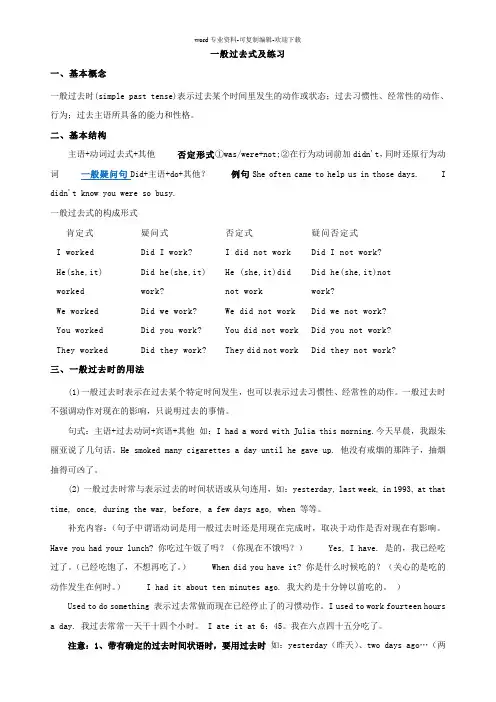
一般过去式及练习一、基本概念一般过去时(simple past tense)表示过去某个时间里发生的动作或状态;过去习惯性、经常性的动作、行为;过去主语所具备的能力和性格。
二、基本结构主语+动词过去式+其他否定形式①was/were+not;②在行为动词前加didn't,同时还原行为动词主语+do+其他?例句She often came to help us in those days. Ididn't know you were so busy.一般过去式的构成形式肯定式疑问式否定式疑问否定式I worked Did I work? I did not work Did I not work?He(she,it) worked Did he(she,it)work?He (she,it)didnot workDid he(she,it)notwork?We worked Did we work? We did not work Did we not work?You worked Did you work? You did not work Did you not work?They worked Did they work? They did not work Did they not work?三、一般过去时的用法(1)一般过去时表示在过去某个特定时间发生,也可以表示过去习惯性、经常性的动作。
一般过去时不强调动作对现在的影响,只说明过去的事情。
句式:主语+过去动词+宾语+其他如:I had a word with Julia this morning.今天早晨,我跟朱丽亚说了几句话。
He smoked many cigarettes a day until he gave up. 他没有戒烟的那阵子,抽烟抽得可凶了。
(2)一般过去时常与表示过去的时间状语或从句连用,如:yesterday, last week, in 1993, at that time, once, during the war, before, a few days ago, when 等等。
一般过去式与过去进行时英语语法
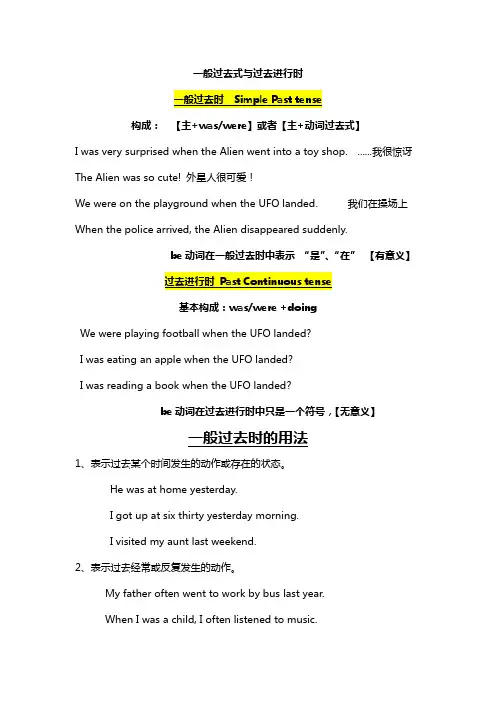
一般过去式与过去进行时构成:【主+was/were】或者【主+动词过去式】I was very surprised when the Alien went into a toy shop. ......我很惊讶The Alien was so cute! 外星人很可爱!We were on the playground when the UFO landed. 我们在操场上When the police arrived, the Alien disappeared suddenly.be动词在一般过去时中表示“是”、“在”【有意义】基本构成:was/were +doingWe were playing football when the UFO landed?I was eating an apple when the UFO landed?I was reading a book when the UFO landed?be动词在过去进行时中只是一个符号,【无意义】一般过去时的用法1、表示过去某个时间发生的动作或存在的状态。
He was at home yesterday.I got up at six thirty yesterday morning.I visited my aunt last weekend.2、表示过去经常或反复发生的动作。
My father often went to work by bus last year.When I was a child, I often listened to music.He always carried an umbrella.常与一般过去时态连用的时间有:①yesterday, yesterday morning, the day before yesterday②last night last week, last month, last year…③two days ago, three years ago…a moment ago=just now(刚才)④in 1990, (in 1998…)⑤this morning, this Monday⑥When I was 5 years old过去进行时的用法:一、过去进行时常表示过去某一时刻或过去某一阶段内正在进行的动作。
一般过去式的结构句型
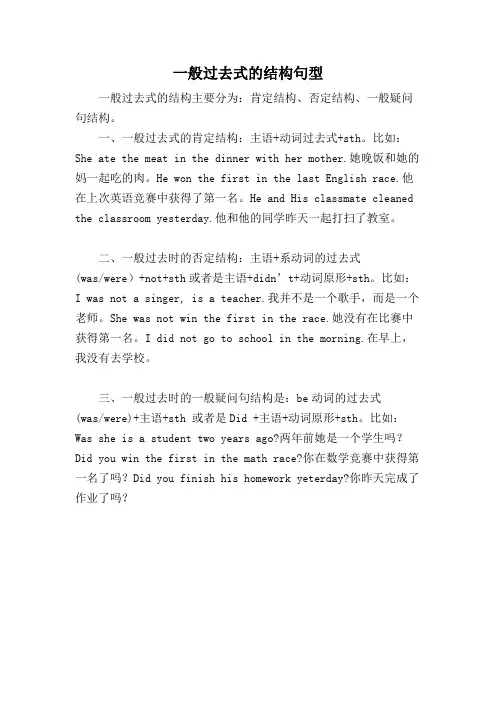
一般过去式的结构句型
一般过去式的结构主要分为:肯定结构、否定结构、一般疑问句结构。
一、一般过去式的肯定结构:主语+动词过去式+sth。
比如:She ate the meat in the dinner with her mother.她晚饭和她的妈一起吃的肉。
He won the first in the last English race.他在上次英语竞赛中获得了第一名。
He and His classmate cleaned the classroom yesterday.他和他的同学昨天一起打扫了教室。
二、一般过去时的否定结构:主语+系动词的过去式
(was/were)+not+sth或者是主语+didn’t+动词原形+sth。
比如:I was not a singer, is a teacher.我并不是一个歌手,而是一个老师。
She was not win the first in the race.她没有在比赛中获得第一名。
I did not go to school in the morning.在早上,我没有去学校。
三、一般过去时的一般疑问句结构是:be动词的过去式
(was/were)+主语+sth 或者是Did +主语+动词原形+sth。
比如:Was she is a student two years ago?两年前她是一个学生吗?Did you win the first in the math race?你在数学竞赛中获得第一名了吗?Did you finish his homework yeterday?你昨天完成了作业了吗?。
一般过去式变化规则
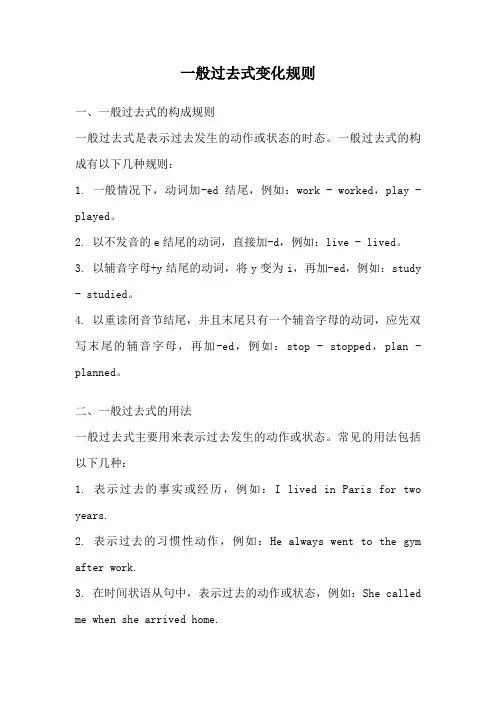
一般过去式变化规则一、一般过去式的构成规则一般过去式是表示过去发生的动作或状态的时态。
一般过去式的构成有以下几种规则:1. 一般情况下,动词加-ed结尾,例如:work - worked,play - played。
2. 以不发音的e结尾的动词,直接加-d,例如:live - lived。
3. 以辅音字母+y结尾的动词,将y变为i,再加-ed,例如:study - studied。
4. 以重读闭音节结尾,并且末尾只有一个辅音字母的动词,应先双写末尾的辅音字母,再加-ed,例如:stop - stopped,plan - planned。
二、一般过去式的用法一般过去式主要用来表示过去发生的动作或状态。
常见的用法包括以下几种:1. 表示过去的事实或经历,例如:I lived in Paris for two years.2. 表示过去的习惯性动作,例如:He always went to the gym after work.3. 在时间状语从句中,表示过去的动作或状态,例如:She called me when she arrived home.三、一般过去式的注意事项在使用一般过去式时,还需要注意以下几点:1. 一般过去式表示的动作或状态已经结束,与现在没有关联。
2. 一般过去式的否定形式是在动词前面加上did not(didn't),例如:I didn't see him yesterday.3. 一般过去式的疑问形式是将did放在句首,例如:Did you watch the movie last night?4. 一些不规则动词的过去式形式需要进行记忆,例如:go - went,have - had。
四、一般过去式的示例下面是一些常见动词的一般过去式示例:1. work - worked2. play - played3. live - lived4. study - studied5. stop - stopped6. plan - planned7. arrive - arrived8. call - called9. see - saw10. go - went11. have - had五、总结一般过去式是表示过去发生的动作或状态的时态,其构成规则有几种,常见的用法包括表示过去的事实或经历,表示过去的习惯性动作以及在时间状语从句中表示过去的动作或状态。
一般过去式的变化规则
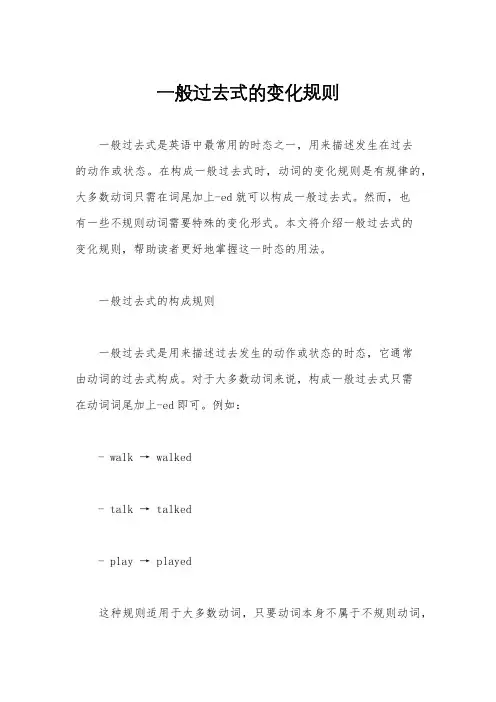
一般过去式的变化规则一般过去式是英语中最常用的时态之一,用来描述发生在过去的动作或状态。
在构成一般过去式时,动词的变化规则是有规律的,大多数动词只需在词尾加上-ed就可以构成一般过去式。
然而,也有一些不规则动词需要特殊的变化形式。
本文将介绍一般过去式的变化规则,帮助读者更好地掌握这一时态的用法。
一般过去式的构成规则一般过去式是用来描述过去发生的动作或状态的时态,它通常由动词的过去式构成。
对于大多数动词来说,构成一般过去式只需在动词词尾加上-ed即可。
例如:- walk → walked- talk → talked- play → played这种规则适用于大多数动词,只要动词本身不属于不规则动词,就可以按照这个规则构成一般过去式。
不规则动词的过去式然而,英语中也有一些不规则动词,它们的过去式并不遵循一般的规则,需要单独记忆。
以下是一些常见的不规则动词及它们的过去式形式:- go → went- eat → ate- see → saw- bu y → bought- have → had- do → did这些动词的过去式形式并不是简单地在词尾加上-ed,而是需要单独记忆。
因此,学习者在掌握一般过去式时,需要特别注意这些不规则动词的变化形式。
一般过去式的用法一般过去式用来描述过去发生的动作或状态。
在叙述过去的经历、事件或习惯性动作时,通常需要使用一般过去式。
例如:- I lived in Paris for three years.(我在巴黎住了三年。
)- She studied English when she was in college.(她上大学时学习了英语。
)- We visited the museum yesterday.(昨天我们参观了博物馆。
)在以上例句中,一般过去式分别用来描述过去的居住经历、学习经历和参观博物馆的经历。
这些动作或状态都发生在过去,因此需要用一般过去式来描述。
一般过去时动词过去式
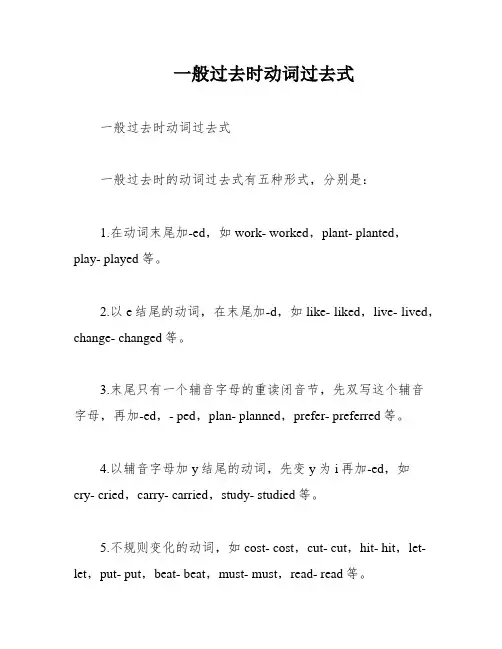
一般过去时动词过去式一般过去时动词过去式一般过去时的动词过去式有五种形式,分别是:1.在动词末尾加-ed,如work- worked,plant- planted,play- played等。
2.以e结尾的动词,在末尾加-d,如like- liked,live- lived,change- changed等。
3.末尾只有一个辅音字母的重读闭音节,先双写这个辅音字母,再加-ed,- ped,plan- planned,prefer- preferred等。
4.以辅音字母加y结尾的动词,先变y为i再加-ed,如cry- cried,carry- carried,study- studied等。
5.不规则变化的动词,如cost- cost,cut- cut,hit- hit,let- let,put- put,beat- beat,must- must,read- read等。
其他不规则变化的动词还有:e- became,come- came,run- ran,bring- brought,catch- caught,dig- dug,feel- felt,have/ has- had,hear- heard,hold- held,keep- kept,will- would,lend- lent,leave- left,make- made,meet- met,pay- paid,say- said,sell- sold,send- sent,shine- shone,sit- sat,sleep- slept,shall- should,spend- spent,tell- told,think- thought,am/ is- was,are- were,begin- began,blow- blew,may- might,break- broke,do- did,draw- drew,drink- drank,drive- drove,eat- ate,fall- fell,fly- flew,et- ot,give- gave,know- knew,lie- lay,ring- rang,see- saw,swim- swam,take- took,wear- wore,write- wrote,learn- learnt/ learned,go- went,grow- grew,mistake- mistook,ride- rode,sing- sang,speak- spoke等。
一般过去时态的结构和用法
一般过去时态的结构和用法
一般过去时表示过去的动作或过去存在的状态,由动词的过去式构成。
动词be的过去式为was/were,have的过去式为had.除不规则动词外,其他动词的一般过去式通常都是在词尾加-ed.
一般过去时的用法
1、表示过去某一确定时间发生的动作或存在的状态,可能是一次性的,也可能是过去经常反复发生的,常与表示过去时间的状语连用。
2、用于虚拟语气中,表示对现在或将来的假设,主观意图或愿望等。
3、在时间、条件状语从句中,常用一般过去时代替过去将来时,表示过去将来的动作。
动词的过去式
动词的过去式一、一般过去时态由动词的过去式表示。
大多数动词的过去式是在动词原形后加上ed构成。
这类动词称为规则动词。
1)一般情况下在词尾直接加ed。
如:play―played 玩work―worked 工作 walk—walked 走路 look—looked 看help—helped 帮助 ask—asked 问 wash—washed 洗 touch—touched 摸2)以e结尾的动词只加d. 如:like--- liked 喜欢love―loved 爱 hope—hoped 希望 close—closed 关3)以辅音字母+Y结尾的动词,变y为i,再加ed. 如:study―studied 学习carry―carried 搬运 copy—copied 抄写 tidy—tidied整理4)以重读闭音节结尾的动词,如果末尾只有一个辅音字母,要双写最后这个辅音字母,再加ed.如:stop―stopped停止 clap—clapped 拍手 nod—nodded 点头二、 --ed的读音规则如下:1)在清辅音后面读[t]. work―worked help―helped2)在浊辅音或元音后读[d]. learn―learned 学习3)在[t] 和[d] 后读[ d]. support―supported 支持三、不以ed 结尾的过去式,称为不规则动词。
我们常用的有:am --was(是) is—was (是) are—were (是)begin—began (开始) bring—brought (拿来) can—could (能)catch—caught (捉住) come—came (来) cut—cut(砍,割)dig—dug (挖,掘) do—did(做,干) draw—drew (画画)drink—drank (喝) drive—drove(驾驶) eat—ate (吃)fall—fell(跌倒,落下) feel—felt (感觉) fly—flew (飞)get—got (获得) give—gave (给) go--went(去)grow—grew (生长) have (has)—had (有) hurt--hurt(伤害)keep—kept (保持) know—knew(知道,认识) learn—learnt (学习)leave—left (离开) let—let(让) lie—lay(躺,平放)make—made (使得,做) may—might(可以) must—must(必须)read—read (读) ride—rode(骑) ring—rang(鸣铃)run—ran (跑) say—said(说) see—saw (看见)sell—sold (卖) send—sent(送) set—set (放)sing—sang(唱歌) sit—sat(坐) sleep—slept(睡觉)smell—smelt (闻) speak—spoke(说话) spend—spent (花费)stand —stood (站立) swim—swam(游泳) take—took (拿到)teach—taught (教) tell—told(告诉) think—thought (认为)throw—threw (投掷) wake—woke (唤醒) write—wrote(写)wear—wore(穿) will—would(将要) win—won(获胜)understand—understood(懂得)。
一般过去式
一般过去式什么是一般过去式一般过去式是英语中表示过去发生的动作或状态的一种时态。
在一般过去式中,动词会发生变化以表示过去的时间。
一般过去式的构成在一般过去式中,一般来说,动词会在其原形基础上加上了-ed来构成过去式。
例如:•work -> worked•play -> played•study -> studied然而,也有一些特殊情况需要注意。
以下是一些常见的规则和例外情况:规则动词大多数动词的一般过去式构成规则如下:•动词以辅音字母+y结尾,将y变为i并加上-ed。
例如:carry -> carried, study -> studied•动词以辅音字母结尾,且以一个元音字母结尾,重叠最后一个辅音字母并加上-ed。
例如:stop -> stopped, plan -> planned•动词以“辅音字母+元音字母+辅音字母”结尾时,重叠最后一个辅音字母并加上-ed。
例如:admit -> admitted, occur -> occurred不规则动词然而,英语中也有一些动词的过去式构成不规则,需要记住这些特殊的形式。
以下是一些常见的不规则动词及其一般过去式形式:•be -> was/were•have -> had•go -> went•do -> did•eat -> ate•see -> saw这些不规则动词的一般过去式形式需要通过背诵并熟记来正确运用。
一般过去式的用法一般过去式通常用来描述已经发生的事情或状态。
以下是一些例句,展示了一般过去式的使用:•I visited my grandparents yesterday.(昨天我去拜访了我的祖父母。
)•She watched a movie last night.(她昨晚看了一部电影。
)•They studied English for two hours.(他们学习了两个小时的英语。
一般过去式知识点
一般过去式知识点嘿,朋友们!咱今天来聊聊一般过去式这个有趣的知识点呀!你想想,一般过去式就像是时间机器,能把我们一下子带到过去呢!它专门用来描述过去发生的事情。
比如说,昨天我去逛街啦,这“去逛街”就是一般过去式。
一般过去式的标志可不少呢!像那些表示过去时间的词,什么昨天、去年、刚才、之前等等,一看到它们,你就得反应过来,这可能得用一般过去式啦。
再说说动词的变化,那可真是像变魔术一样。
大部分动词直接加“ed”,就变得有过去的味道啦。
就好像一个人换了一身古装,一下子就有了过去的感觉。
但也有些调皮的动词,它们变化可不一样哦,得特别记住才行。
比如说“go”的过去式是“went”,这就像是它有自己独特的变身方式。
咱举个例子哈,“I played basketball yesterday.” 你看,“played”就是一般过去式,表示我昨天打篮球这件事已经发生过啦。
要是说“I play basketball every day.”那可就不是一般过去式咯,这说的是每天都做的事情。
你说一般过去式是不是很有意思呀?它能让我们把过去的事情说得清清楚楚。
就好像我们在给别人讲过去的故事一样,用一般过去式就能把那个时候的情景生动地描绘出来。
比如说,你跟朋友讲你小时候的趣事,“I climbed the tree when I was a child.”哇,这一下子就把大家带到了你小时候爬树的那个场景啦!学习一般过去式就像是打开一扇通往过去的门,让我们能更好地表达过去的经历和感受。
它可不是什么难事儿,只要多练习,多说说过去发生的事情,很快就能掌握啦!所以呀,别害怕一般过去式,大胆地去用它吧!让它帮你把过去的精彩都展现出来,和朋友们一起分享那些美好的回忆。
你还等什么呢?赶紧去试试吧!。
- 1、下载文档前请自行甄别文档内容的完整性,平台不提供额外的编辑、内容补充、找答案等附加服务。
- 2、"仅部分预览"的文档,不可在线预览部分如存在完整性等问题,可反馈申请退款(可完整预览的文档不适用该条件!)。
- 3、如文档侵犯您的权益,请联系客服反馈,我们会尽快为您处理(人工客服工作时间:9:00-18:30)。
常表示“正好此时”, “突然” 的意思。 如:I was doing my homework when it began to rain.
过去进行时与一般过去时比较
1.过去进行时表示在过去某个特定时间内正
在进行的动作,强调动作的持续性;而一般 过去时表示过去曾经发生过某事,是个单纯 的过去事件,一个结束了动作。试比较: My brother was downloading some music yesterday afternoon. (昨天下午一直在下载,可能仍没结束) My brother downloaded some music yesterday afternoon. (已下载完了)
2)情态动词
could, would. Could you lend me your bike?
1.
注意:
表示一系列的动作,尽管有先后,都用一 般过去时,最后两个动词之间用and连结。 如: He opened the door, rushed out and then disappeared. 2. 注意在语境中理解“我刚才/原来还不 ……”。如: —Your phone number again? I didn’t quite catch it. —It’s 2566666.
。
TRANSLATE THE FOLLOWING
SENTENCES
1.Christine was an actress all her life. 2.Christine has been an actress all her life. 3.Mrs. Darby lived in Pairs for seven years. 4.Mrs. Darby has lived in Pairs for seven years.
一般过去式& 过去进行时
一般过去时
一般过去时表示过去某个时间发生的动 作或存在的状态。句子的谓语要用动词 的过去式
1)在确定的过去时间里所发生的动
作或存在的状态。 时间状语有: yesterday, last week, an hour ago, the other day, just now, in 1982等。 Where did you go just now?
2.过去进行时可以表示在过去同一时间两个动
作同时进行,用于对比。与之常用的时间副词 有:while, as 而一般过去时没有这种用法。 例如: Paul was doing exercise while Susan was fixing the car. As Michel was visiting Paris, Robert was teaching English classes in Beijing.
2)表示在过去一段时间内,经常性或
习惯性的动作。 When I was a child, I often played football in the street.
注:表示过去经常发生的动作还可用
used to 和would。如: He used to smoke a lot, but he doesn’t now. Whenever we were in trouble, he would help us.
I
intended to have joined their games. —I had intended to join their games.
规则动词过去式的构成
一般动词原形末尾Байду номын сангаас-ed。如:
look→looked, stay→stayed ; 以e结尾的动词只加-d。如:hope→hoped, live→lived; 末尾只有一个辅音字母结尾的重读闭音节的动 词,应先双写这个辅音字母,再加-ed. 如:stop→stopped, plan(计划) →planned; 结尾是“辅音字母+y”的动词,先将y改为i,再 加-ed. 如:study→studied, carry→carried.
2
与一般过去时连用。 过去进行时常与一般过去时连用。 when引导的从句表示一个短暂的时间 点,谓语用一般过去时,while引导的 句子表示一段持续的时间,谓语用过去 进行时。
E.g:My
son fell while he was riding his bicycle and hurt himself. When I got to the top of the mountain, the sun was shining. Laura was making coffee while Peter was washing his car in the garage.
4)
wish, wonder, think, hope 等用 过去时,作试探性的询问、请求、建议 等。 I thought you might have some. 我以为你想要一些。 I wondered if you could lend me your bicycle?
5)在时间、条件、方式、让步等状 语从句中,用一般过去时代替过去 将来时
过去进行时
一、
概念:过去进行时表示在过去某 一时刻或某一段时间内进行或发生的动 作。其形式为was /were + V-ing。
用法
1.表示过去某一时刻或某一段时间正在进行的
动作。 常用的时间状语有: this morning,the whole morning,all day, from nine to ten,this time yesterday, at that time, at six o’clock last night, from six to ten等。如: This time yesterday,I was playing computer games with my brother. What were you doing at 9 last night? It was raining hard when we left the cinema.
She
said she would come if I promised to wait for her. He said he would not go if it rained.
注意:
用过去时表示现在,表示委婉
语气。 1)动词want, hope, wonder, think, intend 等。 Did you want anything else? I wondered if you could help me.
3)句型:
It is time for sb. to do sth "到 ……时间了" "该……了“ It is time sb. did sth. It is time sb. should do sth.
would
(had) rather sb. did sth. 表示'宁愿某人做某事' I'd rather you came tomorrow.
特别说明
有些动词的过去时,如:expect,
hope, intend, plan, want 等后接不定式的完成 时;或它们的过去完成时接不定式的一般 式,都可表示过去未曾实现的意图、打算 或希望。如: I hoped to have been invited to his wedding party. —I had hoped to be invited to his wedding ceremony.
